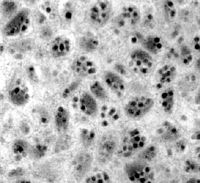Polydnavirus
| Polydnavirus | |
|---|---|
| Virus classification | |
| Group: | Group I (dsDNA) |
| Family: | Polydnaviridae |
| Genera | |
A polydnavirus /pɒˈlɪdnəvaɪərəs/ (PDV) is a member of the family Polydnaviridae of insect viruses. There are currently 53 species in this family, divided among 2 genera. Polydnaviruses form a symbiotic relationship with parasitoid wasps (ichnoviruses occur in ichneumonid wasps species and bracoviruses in braconid wasps), but these wasps are themselves parasitic on Lepidoptera (moths and butterflies). Little or no sequence homology exists between BV and IV, suggesting that the two genera evolved independently for a long time.
Group: dsDNA
Viruses in Polydnaviridae are enveloped, with prolate ellipsoid and cylindrical geometries. Genomes are circular and segmented, composed of multiple segments of double-stranded, superhelical DNA packaged in capsid proteins. They are around 2.0–31kb in length.
Viral replication is nuclear. DNA-templated transcription is the method of transcription. The virus exits the host cell by nuclear pore export. Parasitoid wasps serve as hosts for the virus, and Lepidoptera serve as hosts for these wasps. The female wasp injects one or more eggs into its host along with a quantity of virus. The virus and wasp are in a mutualistic symbiotic relationship: expression of viral genes prevents the wasp's host's immune system from killing the wasp's injected egg and causes other physiological alterations that ultimately cause the parasitized host to die. Transmission routes are parental.
...
Wikipedia

